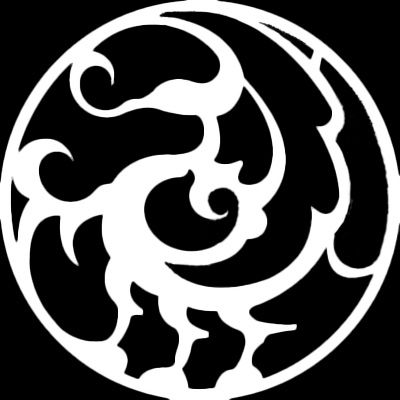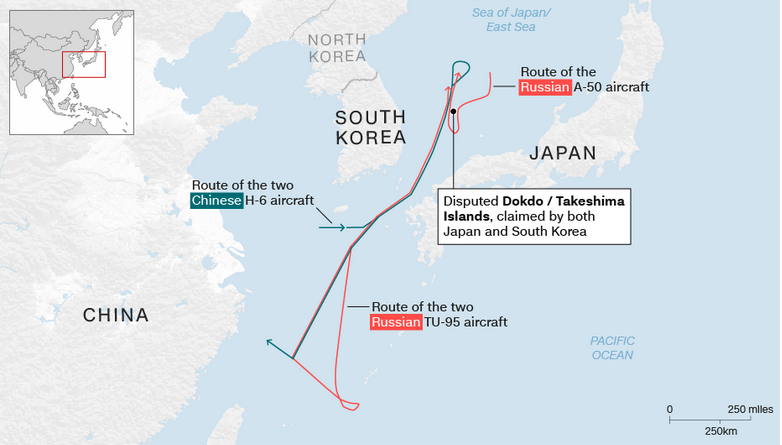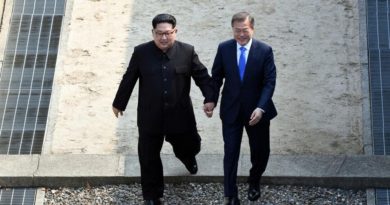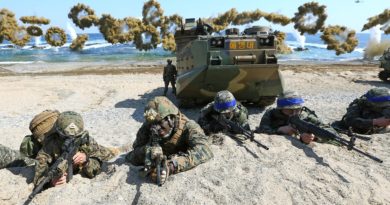China and Russia Violate Korean Airspace
Early Tuesday morning, the Chinese and Russian air forces executed a joint long-range air patrol in the Asia-Pacific region. The Russian Defense Ministry indicated that this was the first time Russia participated in a long-range joint air patrol, though Russian troops have taken part in joint exercises with PRC troops previously. The participating aircraft in this exercise were two Russian TU-95 bombers, two Chinese H-6 bombers, a Russian A-50 and a Chinese KJ-2000. Both the ROK and Japanese governments lodged protests in response to this provocation.
Timeline of Events
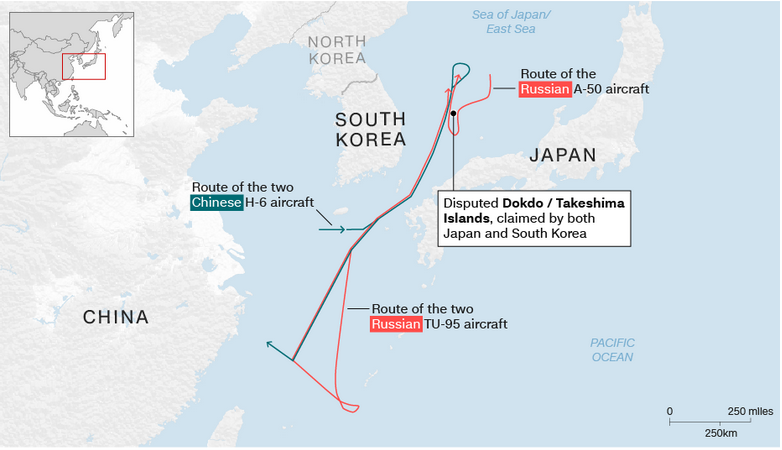
- 0644 local: Two Chinese H-6 bombers passed into ROK ADIZ near Soctora Rock
- 0840 local: Two Russian Tu-95 bombers join the H-6 bombers and cross into ROK ADIZ near Ulleungdo; they stay for 24 minutes
- 0909 local: Russian A-50 AEW&C flies above the Liancourt Rocks; ROK F-15 and F-16 jets respond and fire 80 warning shots
- 0933 local: A-50 returns above the Liancourt rocks and ROK fighters fire another 280 warning shots
The PRC H-6 bombers crossed into the ROK’s Air Defense Identification Zone near the Soctora Rock — a contested submerged rock that the ROK calls Ieodo and the PRC calls Suyan. The KADIZ was updated in 2013 to include this submerged rock, though the PRC does not recognize the ADIZ. Moreover, Japan’s own ADIZ includes the Soctora Rock, which makes this region of the East China Sea an area where the three countries ADIZ overlap.
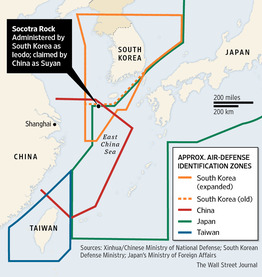
The H-6 and Tu-95 bombers then entered the KADIZ near another contested islet: the Liancourt Rocks. While the bombers did not directly fly over the rocks, the A-50 did fly over the rocks and was intercepted by two ROK fighters. Interestingly, these fighters reportedly fired warning shots at the A-50 prompting it to leave ROK airspace. However, the A-50 returned and was met with nearly 300 warning shots. This is a remarkable escalation in the region and one that Russia has not been involved in previously. The Japanese also indicated that fighter jets were scrambled, though it is unclear where those jets were located.
Mission Objectives
According to the Russian Ministry of Defense:
“The joint patrol was carried out with the aim of deepening Russian-Chinese relations within our all-encompassing partnership, of further increasing cooperation between our armed forces, and of perfecting their capabilities to carry out joint actions, and of strengthening global strategic security.”
Also, former Russian Army Colonel Dmitri Trenin indicated:
Thus, it is probable that this patrol will be followed by similar patrols in the region. Last year, the PRC participated in the Vostok Exercises in the Russian Far East and we should expect more Russian and Chinese mil-to-mil collaborations in the future. These joint exercises serve two purposes: one diplomatically and one operationally.
First, this mission — like the Vostok Exercise — served to signal regional states that PRC and Russian cooperation is growing. Further, the same signal is being sent to the US while National Security Advisor John Bolton is in Seoul. The use of strategic bombers and Airborne Early Warning & Command aircraft reflect the ability of the Chinese and Russians to prosecute missions and maintain Command and Control of the battlespace. Moreover, Russia’s violation of ROK airspace, specifically over the Liancourt Rocks, served to provoke a Japanese response and further drive a wedge into the trilateral security framework. Already, Japan has lodged a formal complaint against the ROK for taking action within Japanese airspace.
Second, this mission helped to demonstrate and test PRC and Russian joint interoperability in the air after the two countries have exercised naval and ground troops. Also, the AEW&C aircraft were demonstrating their capabilities to conduct C2 operations in the battlespace, while also collecting intelligence on ROK and Japanese air defense systems and response times. Further exercises will fill in the gaps within this capability and provide additional intelligence gathering for the two countries.
Conclusion
As the US attempts to manage its key allies in the region, the PRC and Russia are ramping up pressure on the ROK. The PRC aims to exploit economic relations with the ROK and exacerbate ROK-Japan diplomatic issues. Likewise, Russia aims to inflame the ROK-Japan diplomatic row to disrupt the US-led trilateral security framework in the region. Meanwhile, US leadership has been unable to prevent ROK leadership from engaging in reckless behavior.
At this time, the US and the ROK are set to begin the 19-2 Dong Maeng Exercise mid August. Secretary for Peace Planning Choi Jong Kun told reporters, “As far as I know, President Trump did not promise the cancellation of this upcoming military exercise.” Given the lack of US-DPRK negotiations and the DPRK’s statements about the exercise, I would expect some low-level provocation from the DPRK at that time — if President Trump does not cancel the exercise before then.
